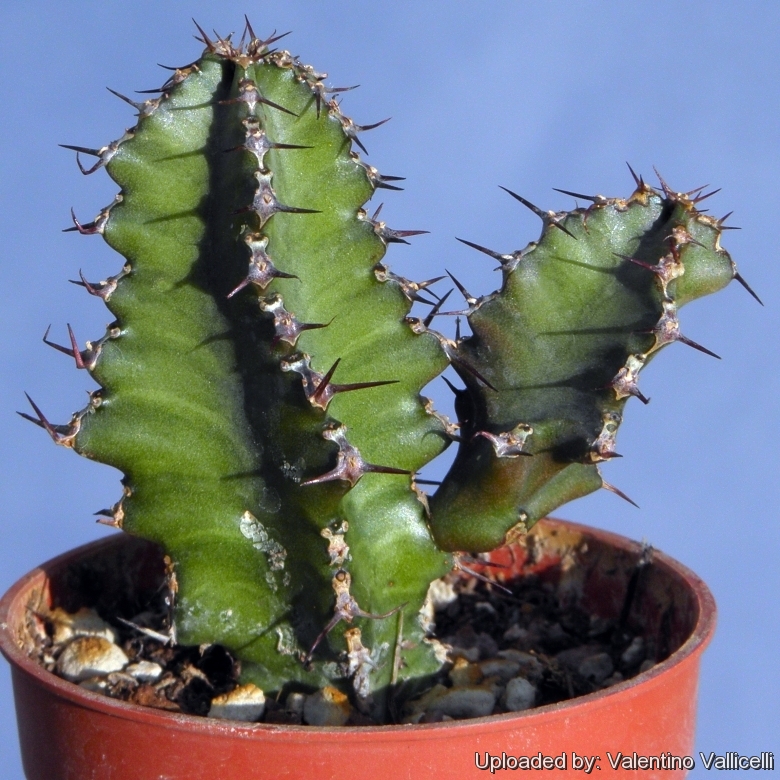




Your support is critical to our success.

Origin and Habitat: Republic of South Africa, Northern Province, known from the type locality only in two small colonies in the Drakensburg mountains.
Altitude: 1500 metres above sea level.
Habitat: It grows on shallow soil in rock crevices in the Wolkberg Dolomite Grassland characterised by short, closed grasslands rich in forb and grass species, and shares its habitat with Aloe dolomitica, Aloe vryheidensis and Euphorbia schinzii. This species has been lost to cultivation for many years but rediscovered in the mid 1980's.
Synonyms:
- Euphorbia restricta R.A.Dyer
Description: Euphorbia restricta is a small spiny, succulent subshrub, basally branching, from a large tuberous root and usaually less than 30 cm tall. The Euphorbia restrictaSN|21535]]SN|21535]] has stems branching freely.
Roots: Tuberous, merging into stem, 4 - 8 cm in diameter, branching sparsely at ground-level, each with a tuft of branches.
Stems: Branches simple, short, thick, arcuate to sprawling, up to 16 cm long, with 4 shallow ribs, but occasionally there may be more ribs (up to 6), to 3 cm wide, constricted into ovate segments to 2 cm cm long, angles deeply winged with sinuate teeth to 7,5 mm apart.
Spines shield: Joined in a horny line of entire spine shields.
Spines: Two pairs of spines occur each node, one pair, sharp up to 1 cm long and the other pair (stipular spines) minute reduced to mere prickles.
Inflorescences: Cymes, solitary, simple, subsessile.
Flowers: Cyathia to 6 mm in diameter. Nectar glands oblong, yellow, just touching.
Fruits: Obtusely lobed, 2,5 x 6 mm broad, sessile.
Seeds: Subglobose smooth.
Similar species: Euphorbia restrictaSN|21535]]SN|21535]] resembles Euphorbia barnardii on a miniature scale. In general appearance, E. restricta suggests a stunted form of E. barnardii.
Bibliography: Major references and further lectures
1) Urs Eggli “Illustrated Handbook of Succulent Plants: Dicotyledons” Volume 2. Springer, 2002
2) David Hardy, Anita Fabian, Gerrit Germishuizen “Succulents of the Transvaal” Southern Book Publishers, 1992
3) "Fauna and flora", editions 36-48 Transvaal Nature Conservation Division., 1980
4) Van Wyk, B-E., Van Heerden, F. & Van Oudtshoorn, B. “Poisonous plants of South Africa. Briza” Publications, Pretoria. 2002.
5) White, A., Dyer, R.A. & Sloane, B.L. 1941. ”The succulent Euphorbieae, vol. 2.“ Abby Garden Press. Pasadena, California.
6) Becker R., Moller A., Krynauw S. and Engelbrecht D. “The status of Euphorbia restricta at its type locality in the Wolkberg Wilderness Area, Limpopo Province.” Euphorbia World. (In Press)
Cultivation and Propagation: Euphorbia restricta is another easy plant to grow. It makes great potted specimens.
Growth rate: It grows well, though slowly, but it possible to increase the speed of growth to some extent by providing adequate amount of water, warmth, and a liquid fertilizer diluted half strength during the active growing season, but it’s susceptible to rotting if too wet. Most plants will offset readily, and small clumps can be produced in a few years.
Soil: It likes porous substrata with adequate drainage. Outdoors it does well on poor, rocky soils.
Exposure: Need bright light (but not blasting sun in summer) to partial shade for best appearance. It responds well to warmth, with its active growth period in the late spring and summer months. If grown indoor provide 4 to 6 hours, or more, direct morning or afternoon sun.
Watering: Water thoroughly when soil is dry to the touch during active growing season (more than once a week during hot weather) In the winter months, waterigs should be suspended or restricted to once over the winter. The most common failure in growing this plant is over watering, especially during the winter months.
Hardiness: Protect from frost. During winter month, put them in a cool luminous place and encourage them to enter winter dormancy by withholding water and fertiliser over the winter as they will etiolate, or become thin, due to lower levels of light.
Maintenance: Repot every two years. It like pots with generous drain holes.
Reproduction: It is propagated by cuttings. The seeds may be germinated and grown in containers. Their main requirements consist of high humidity levels, free-draining soil mix, and enough water, light, and nutrition. It is recommend taking Euphorbia cuttings in Spring/Summer when the plant is growing so that they have a better chance of success. They key is heat & good air circulation. These cuttings should be dipped in Hormone powder (but it is not needed) and left for a period of 3-4 weeks to callous. Then pot the cutting and don't water ( or kept slightly moist) until rooted. These will root just fine, if you can put the pot outside in the summer, or put pot on a heating pad.
Warning: As with all other Euphorbias when a plant get damaged it exudes a thick white milky sap known as latex. This latex is poisonous and particularly dangerous for the eyes, skin and mucous membranes. So pay extreme attention not to get any in your eyes or mouth. Cultivated plants must be handled carefully.
| Your Actions | |
|---|---|
| Back to Euphorbia index | |
| Back to Euphorbiaceae index | |
 |
Back to Succulents Encyclopedia index |
Privacy stantement - Terms and conditions - How to cite - About us - Feedback - Donate




